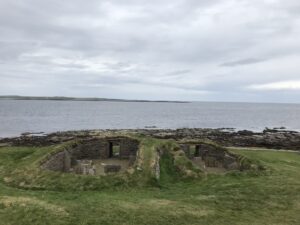
The development of farming in Neolithic Orkney is a fascinating topic that has inspired research over the last century. From the days of Gordon Childe, through the work of Colin Renfrew to the publications of Anna and Graham Ritchie and the fieldwork of Colin Richards there have been many many archaeologists who wish to unpick the rich Neolithic record of Orkney. Many continue to do so and there is a wealth of literature on the subject.
It seems strange, then, that, in addition to this, the archaeology of Neolithic Orkney has also prompted an outpouring of catastrophe theories. In recent weeks I have had correspondence on meteor strikes, volcanic eruptions with associated ash fall and or sulphuric rains, and tsunamis. All of which may, apparently, have played a role in limiting farming, especially towards the end of the period. In these circumstances I am amazed that anyone (or any monuments) survived such difficult times.
One problem seems to me to be that, despite evidence for these events elsewhere, no one has yet published good geoscience evidence for them in Orkney. It seems a little strange when there is a plethora of Orkney-based archaeological research, much of which includes palaeoenvironmental assessments. The lack of detail, including dates and sample information makes it hard to assess the impact of events like these on the local community. Could it, one wonders, show up in changes to the architectural tradition, or farming record? Thankfully, other research suggests that, while there was some decline of agricultural activity in more marginal areas into the Early Bronze Age in some parts of Orkney, in other places agriculture may actually have expanded into and during the Bronze Age.
The (changing) evidence of the past aside, I am curious as to why these Neolithic catastrophe theories have become so popular. Do they represent a manifestation of twenty-first century concerns as we struggle with the changes that we now face? In contrast to many of our ancestors, the population of today has been able to take advantage of centuries of relative geographical stability, especially in this corner of northwest Europe. While this has undoubtedly been a good thing, it has also lulled us into a false sense of security. In the face of stability, the current threats of climate change and relative sea-level rise gain momentum. Added to which we are far less flexible than our ancestors and the density of modern populations create their own issues. We certainly face problems.
I wonder whether those who promote the cataclysms of the past have tapped into a general need for excitement? Or is it more a need for reassurance? Do we feel the need to remind ourselves that the human race can survive, even thrive, when things go wrong? Is there a generic requirement for a ‘millennium bug’ style threat to keep us on our toes? I think I may have to settle down with a calming mug of hot chocolate while I wait to hear of the next disaster that lay in wait for those who lived in these islands some five thousand years ago.
It is all part of the entertainment of life as an archaeologist.
You must be logged in to post a comment.